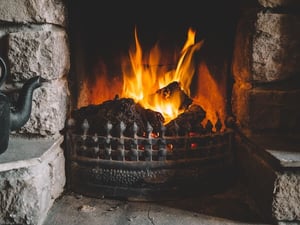 Nothing warms a space quite like a fireplace -- and we're not just talking about in the literal sense. Fireplaces have the potential to turn just about any space into a cozy, inviting one, which is why they are such a popular feature in outdoor kitchens and patio areas.
Nothing warms a space quite like a fireplace -- and we're not just talking about in the literal sense. Fireplaces have the potential to turn just about any space into a cozy, inviting one, which is why they are such a popular feature in outdoor kitchens and patio areas.
To ensure that your fireplace truly enhances your outdoor living space, though, you must properly maintain it. Let's discuss necessary maintenance tasks for outdoor fireplaces, whether wood-burning or gas.
Maintaining your wood-burning fireplace
One important thing to watch out for when it comes to wood-burning fireplaces is creosote. In most cases, creosote can be managed with creosote sweeping logs, but if the build-up becomes thicker than 1/8 of an inch, you will need to scrub it with a towel or brush.
Each time you use your fireplace, be sure to clean the soot and remove the ashes that the burned logs left behind. You should be able to sweep up the ashes with a broom — unless, that is, you've had a few fires since the last time you swept, and the ashes have piled up considerably. In that case, a shovel also works to transport the ashes from the fireplace to a metal bucket. Remember to never put your ashes inside flammable materials such as a paper or plastic. Metal is the safest choice, and even then, let the ashes sit overnight before throwing them out.
If you're guilty of neglecting to remove the ashes from your fireplace as often as you should, here are two incentives:
- Sprinkling ashes in your garden will increase the nutrients in the soil.
- Regularly cleaning up ashes will keep them from staining your fireplace or leaving messy puddles when it rains.
Cleaning your gas fireplace
While gas-powered fireplaces do not need to be cleaned as often or intensely as wood-burning fireplaces, they still require regular maintenance.
Soot builds up on gas fireplaces, too, usually around the burners. The best way to remove the soot is with a cloth or bristled brush — but only after you turn off the gas. Safety first!
Pilot lights and exhaust fans are unique to gas fireplaces. If you know you won't be using your fireplace again for a few months, turn the pilot light off, and if your fireplace has an exhaust fan, check it regularly to make sure it's working.
Other hot tips for an outdoor fireplace
Keep plants like grass and vines from growing on or around your fireplace exterior. Root systems have the power to damage and crack stone and brick structures.
Another important maintenance tip is to always follow the manufacturer's instructions for cleaning your fireplace. Failing to do so could void the warranty.
Lastly, get your fireplace professionally inspected at least once a year. This is especially important for the chimney. Chimney sweeps will clean your chimney and identify issues that you're unable to see.
Want a designer's perspective on an outdoor fireplace for your home? Contact us today!

